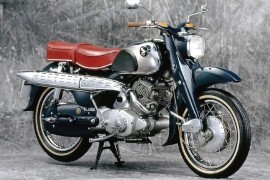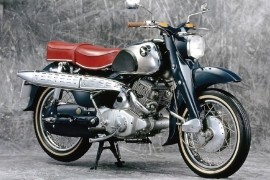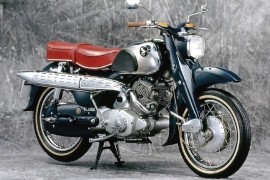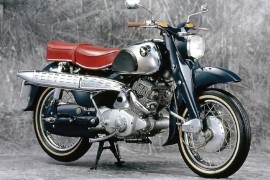HONDA CS Models/Series Timeline, Specifications & Photos
First production year: 1957
In 1960, Honda released the Honda CS 71 Dream, a classic motorcycle made by the House of Tokyo and one of the first mass-produced, larger displacement machines exported worldwide by the Japanese brand.
The Honda C71 and C72, along with the identical C76 and C77 motorcycles, were the first larger-capacity motorcycles that were mass-exported by Honda. The bikes were characterized by a pressed steel frame, an alloy overhead cam, a twin-cylinder engine, and well equipped with 12-volt electrics, an electric starter, turn signals, a dual seat, and other advanced features.
Like previous models, the 1960 machine had standard features such as a large valanced front fender, a small square headlight, a one-piece dual seat, a high-mounted chromed exhaust system, side-mounted rear shocks, a center stand, and wire-spoke wheels.
It was built around a steel frame with a hydraulic telescopic fork mounted on the front and dual side-mounted shock absorbers mounted on the rear, offering optimum suspension performance and handling capabilities.
Braking-wise, the motorcycle's 16-inch wheels were fitted with drum braking units both front and rear, providing optimum braking performance.
As for the power figures, the 1960 Honda CS 71 Dream delivered 18 hp at 7,400 rpm from its 247cc air-cooled four-stroke twin-cylinder engine mounted at its core. The power produced by the engine was transferred to the rear by a four-speed manual transmission and a final chain drive.
The Honda C71 and C72, alongside the identical C76 and C77 models, were the first larger-capacity motorcycles mass-exported by Honda. The bikes were characterized by a pressed steel frame, an alloy overhead cam, a twin-cylinder engine, and well equipped with 12-volt electrics, an electric starter, turn signals, a dual seat, and other advanced features.
In 1959, the Japanese motorcycle producer released the Honda CS 71 Dream, a quarter-liter motorcycle that packed the same technical, visual, and performance characteristics as the previous one without significant changes.
The bike was manufactured around a steel frame that housed the suspension system, comprised of a hydraulic telescopic fork mounted on the front and dual side-mounted shock absorbers mounted on the rear, offering optimum suspension performance and handling capabilities.
In the braking department, both 16-inch wheels were controlled by drum braking units, providing optimum stopping power.
As for performance, the 1959 Honda CS 71 Dream had installed a 124cc four-stroke air-cooled twin-cylinder engine underneath the fuel tank, boasting 18 hp at 7,400 rpm. A four-speed manual transmission and a final chain drive redirected the power to the rear wheel.
The bike's visual department had features like a large valanced front fender, a small square headlight, a one-piece dual seat, a high-mounted chromed exhaust system, side-mounted rear shocks, a center stand, and wire-spoke wheels.
In 1958, the Japanese bike maker released the Honda CS 71 Dream, one of the first larger displacement motorcycles exported by Honda. It had a high-mounted exhaust system, sold well in the home market, and became a gem among Japanese collectors.
The Honda C71 and C72, alongside the C76 and C77, were the first larger-capacity motorcycles mass-exported by Honda. The bikes were characterized by a pressed steel frame, an alloy overhead cam, a twin-cylinder engine, and well equipped with 12-volt electrics, an electric starter, turn signals, a dual seat, and other advanced features.
The 1958 model had features such as a large valanced front fender, a small square headlight, a one-piece dual seat, a high-mounted chromed exhaust system, side-mounted rear shocks, a center stand, and wire-spoke wheels.
The 1958 Honda CS 71 Dream was powered by a 247cc air-cooled four-stroke twin-cylinder engine fed by a carburetor. The engine boasted an output power of 18 hp at 7,400 rpm, sent to the rear wheel with a four-speed manual transmission and a final chain drive.
For suspension, the motorcycle packed a hydraulic telescopic fork mounted on the front and dual side-mounted shock absorbers mounted on the rear, offering optimum suspension performance and handling capabilities.
As for stopping power, the motorcycle's 16-inch wheels were fitted with drum units, providing optimum braking performance.
The Honda C71 and C72, alongside the C76 and C77, were the first larger-capacity motorcycles mass-exported by Honda. The bikes were characterized by a pressed steel frame, an alloy overhead cam, a twin-cylinder engine, and well equipped with 12-volt electrics, an electric starter, turn signals, a dual seat, and other advanced features.
In 1957, the Japanese motorcycle manufacturer launched the Honda CS 71 Dream, a motorcycle with high exhaust pipes that sold well in the home market and ended up a gem among Japanese collectors.
The bike's visual department had standard features, such as a large valanced front fender, a small square headlight, a one-piece dual seat, a high-mounted chromed exhaust system, side-mounted rear shocks, a center stand, and wire-spoke wheels.
The bike was built around a steel frame with a hydraulic telescopic fork mounted on the front and dual side-mounted shock absorbers mounted on the rear, offering optimum suspension performance and handling capabilities.
As for the braking power, the bike's 16-inch wheels were fitted with drum braking units, providing optimum braking performance.
In the performance department, the 1957 Honda CS 71 Dream had its heartbeat set by a 247cc air-cooled four-stroke twin-cylinder engine managed by a carburetor. The engine delivered an output power of 18 hp at 7,400 rpm, sent to the rear wheel with a four-speed manual transmission and a final chain drive.



